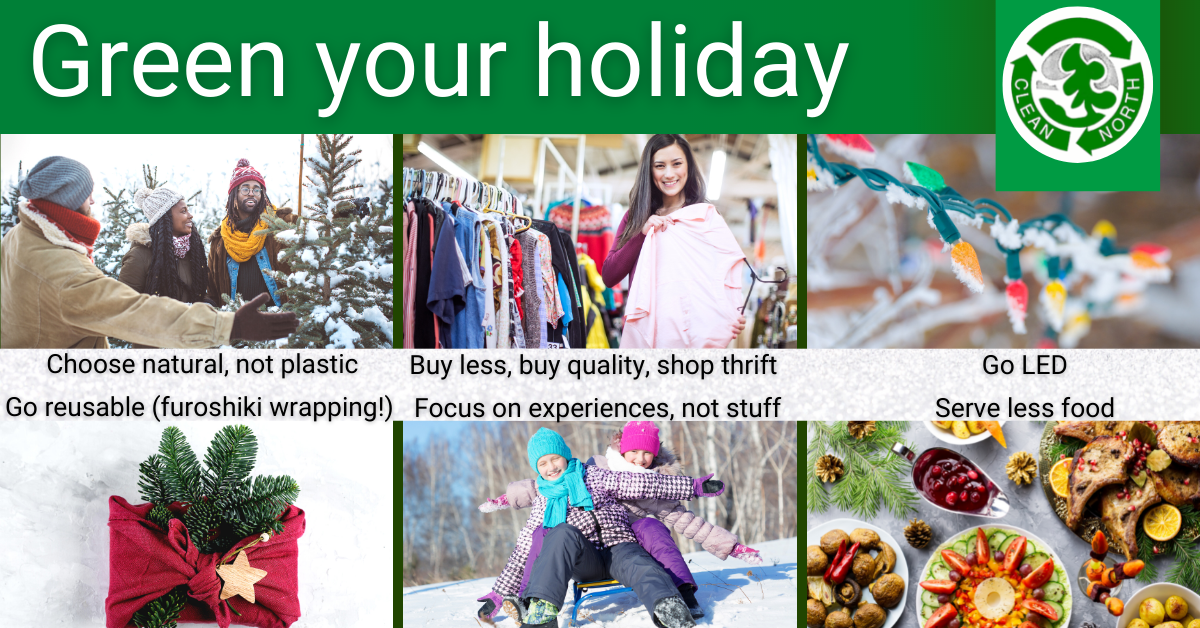
December brings a myriad of holidays and celebrations, but too often, these events come with lots of waste. We have ideas for reducing your “waste” line this holiday season, with trimming your costs being a bonus.
Go natural
Cheap plastic items are bought in massive quantities at holiday time. Most end up in the landfill, where they can leach toxic chemicals and heavy metals into our soil and water and take up to 500 years to break down. Whenever possible, buy items made out of glass, wood, natural fibres, cardboard, or paper instead. This goes for everything from Christmas trees to holiday decorations to decor to giftwap.
One source for sustainable products (such as brushes made from natural materials, beeswax candles, and compostable Swedish dishcloths) is Hearterra at 73 Brock St (Soo Market), a locally owned business.
Another way to go natural is to source unique glass containers at thrift stores and have them filled with body butter or bubble bath for one-of-a-kind gifts. Sault Ste. Marie has two locally owned refilleries, Hearterra and OC Beauty (in Steelton). Both refill personal care and cleaning products, and Hearterra refills olive oils and vinegars as well.
Buy less, buy quality, shop thrift
Resist the temptation to overshop at holiday time. Buy less, go for quality items that last longer, and shop secondhand. One of our thrift-store-loving volunteers recently found two 100% cashmere sweaters and another 100% merino wool one for a fraction of their original cost!
Another way to reduce your shopping footprint is to buy items made by local artisans—maple and honey products, jams, pickles, jewellery, ornaments, socks, scarves, mitts, toques. This puts money back into our local economy and reduces emissions from transporting cheap goods from Asia.
And don’t forget reusable shopping bags. Putting a note on your dashboard can help you remember to bring them into stores.
Go LED
Look for ways to reduce energy use over the holidays. Holiday lighting can be a huge energy sinkhole, adding to carbon emissions as well as your PUC bill. Put up fewer lights and switch to LEDs, which use much less energy.
You can also cut energy use by not heading out for just a few items. Keep a running list of what you need and make fewer trips each week. This will trim fuel costs, too!
Go reusable
Switching to reusable gift wrap can slash how much waste your household produces during the holidays. Adding to paper wrap’s environmental impact is its poor quality and common foil or plastic embellishments, which render it un-recyclable. Some alternatives:
- Furoshiki (the Japanese art of wrapping with pieces of cloth such as bandanas)
- Cut-up white or brown kraft paper shopping bags or newspaper
- Reusable gift bags and boxes (ideally 100% paper/cardboard ones as those with plastic/foil on them can’t be recycled)
You can top off gifts with natural decorations like jute twine/bows, the covers of last year’s Christmas cards, and pine needle sprigs/cones.
Consider alternatives to other single-use items as well: napkins, plates, cups, cutlery, single-use water bottles, straws, etc.
When it comes to Christmas trees, read up on whether artificial or cut natural trees are more environmentally friendly. If you want to go super green and are ok with a smaller tree, consider a potted Norfolk Island pine or other conifer. However, keep in mind they need a lot of light, the Norfolks are not winter hardy, and even the native ones cannot be put outside or planted until spring.
If you choose a cut natural tree, remember that starting on Boxing Day, Clean North will be collecting these at Cambrian Mall to recycle into mulch.
Focus on experiences
Your kids are more likely to remember the fun they had with family during holidays rather than the gifts. So consider giving less stuff and more “experience” gifts:
- Music, art, or other types of lessons
- Tickets for live theatre performances, concerts, sporting events, charity fundraiser draws (Sault Area Hospital Foundation and ARCH hospice have 50:50 draws)
- Skating, tobogganing, skiing, and snowshoeing outings
- Travel
If you have less-mobile family members, perhaps attend a holiday concert, make cookies together, have a creative cocktail/mocktail contest or other culinary challenge, or have board game nights.
For the civic minded in your family, consider a membership in or donation to a local charity or conservation organization (for example, Clean North; the Algoma Highlands, Kensington, or Lake Superior Watershed conservancies; or the Voyageur Trail Association).
Serve less food
Canada is one of the worst offenders in the world when it comes to food waste. According to the Love Food Hate Waste website, we in the Great White North waste a shocking 2.3 million tons of food per year.
Food waste comes with a heavy environmental burden. In landfills, it emits methane, a far more powerful greenhouse gas than carbon dioxide. And it’s a shame that we waste so much food when so many do not have enough to eat.
Consider reducing how many batches of cookies you make or how many side dishes you cook for holiday meals. Cutting back on how much you serve will also reduce strain on your wallet.
If you are able, consider donating an equivalent amount of food to a food bank such as the Soup Kitchen Community Centre, St. Vincent Place, SOYA, or Harvest Algoma.
Hold big business and governments accountable
Finally, keep in mind that while the collective action of individuals can have a huge impact, corporations and governments have a role to play, too. Look into the environmental track record of companies you do business with, and vote with your dollars. And pay attention to what governments at all levels are doing (and not doing) to reduce waste and protect environmental health.
Questions?
Email us at info@cleannorth.org.




